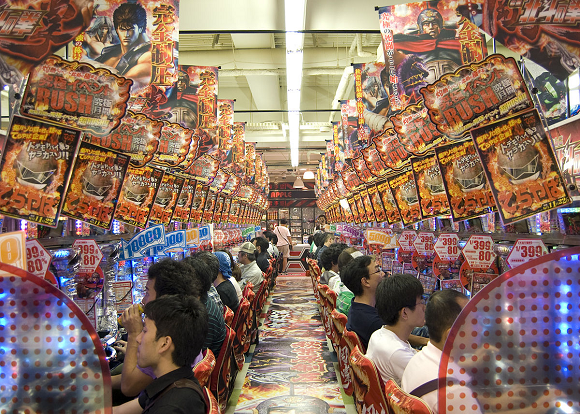
A grim mortality rate for pachinko parlor management companies shines a light on the poor health of the industry.
I’ve lived in the same neighborhood of Yokohama for more than a decade now, and right across the street from my train station is a pachinko parlor. I’ve never gone inside, and a recent study suggests that I’m not the only one for whom the allure of bouncing metal balls holds no strong allure.
The Tokyo-based Yano Research Institute recently released the results of its analysis of the pachinko industry, and some of the numbers don’t look so good . At the end of last December, researchers counted 10,258 pachinko halls in Japan, and while that’s definitely a lot, that’s how many were left over after 420 shut down during the year, meaning that roughly one in 25 pachinko halls closed their doors for good in 2017.
Even more startling is that 177 companies that manage pachinko parlors went out of business in 2017, with the remaining 3,244 meaning there was more than a five-percent mortality rate for pachinko operators during the year.
So what’s causing the drops? One thing researchers point to is the rapidly expanding number of entertainment options that people in Japan have access to. While the country was slow to embrace Internet surfing via PCs, smartphones have quickly become the norm, providing people anywhere in the country access to a nearly unlimited amount of reading material, video content, and games. This especially changes the entertainment landscape in rural areas, where massive pachinko halls used to often be just about the only leisure providers to be found.
There’s also the fact that no matter how many anime and video game franchises pachinko machine manufacturers license in an attempt to appeal to those hobbies’ younger fanbases, pachinko is widely seen as the pastime of stodgy middle-aged and older men. Japanese survey site Shirabee asked 235 men and women, all who said they enjoyed gambling, whether or not they felt like the money they’d spent on pachinko and other games of chance had been a waste, and 62.5 percent of respondents in their 20s said it had been, as did 63.1 percent of those in their 30s. Those numbers contrast with 48.8 percent of respondents in their 40s, 54.3 percent of those in their 50s, and just 46.5 percent of those 60 and above.
That gap in attitudes suggests that convincing younger Japanese people that sitting in a pachinko parlor is a fun way to spend the day is an uphill battle. Granted, some would argue that all of the randomized loot box microtransactions of wildly successful smartphone games are just as much a form of gambling as pachinko, but others would counter that at least in that case, the buyer knows he’s going to get some sort of video game goodies, whereas an unsuccessful pachinko session will leave you without even enough balls to trade in for a box of crackers, let alone the trinkets that you can secretly exchange for cash around the corner.
With more than 10,000 halls still left, it’s not like pachinko is going to disappear overnight. However, it’s estimated that the number of active pachinko players in Japan has dropped from 30 million in 1994 to just 9.4 million now, and if that trend continues, pachinko parlors might meet the same fate as sento (public baths), going from a ubiquitous part of Japanese cityscapes to a legitimate rarity.
Source: Niconico News via Jin, Gambling Journal
Top image: Wikipedia/Tischbeinahe
Insert images ©SoraNews24

 Nearly five percent of Japanese are addicted to gambling – even though it’s still “illegal”
Nearly five percent of Japanese are addicted to gambling – even though it’s still “illegal” Number of pachinko parlors in Japan decreasing rapidly, down 12 percent in two years
Number of pachinko parlors in Japan decreasing rapidly, down 12 percent in two years Proposed facial recognition system would send warning emails to families of pachinko addicts
Proposed facial recognition system would send warning emails to families of pachinko addicts Man tries something unique to appease the pachinko gods –- totally worth it?
Man tries something unique to appease the pachinko gods –- totally worth it? Angry customer smashes pachinko machines with hammer 【Video】
Angry customer smashes pachinko machines with hammer 【Video】 Foreigner’s request for help in Tokyo makes us sad for the state of society
Foreigner’s request for help in Tokyo makes us sad for the state of society Japanese city loses residents’ personal data, which was on paper being transported on a windy day
Japanese city loses residents’ personal data, which was on paper being transported on a windy day Harajuku Station’s beautiful old wooden building is set to return, with a new complex around it
Harajuku Station’s beautiful old wooden building is set to return, with a new complex around it Historical figures get manga makeovers from artists of Spy x Family, My Hero Academia and more
Historical figures get manga makeovers from artists of Spy x Family, My Hero Academia and more Ghibli Park now selling “Grilled Frogs” from food cart in Valley of Witches
Ghibli Park now selling “Grilled Frogs” from food cart in Valley of Witches McDonald’s new Happy Meals offer up cute and practical Sanrio lifestyle goods
McDonald’s new Happy Meals offer up cute and practical Sanrio lifestyle goods Japanese ramen restaurants under pressure from new yen banknotes
Japanese ramen restaurants under pressure from new yen banknotes Suntory x Super Mario collaboration creates a clever way to transform into Mario【Videos】
Suntory x Super Mario collaboration creates a clever way to transform into Mario【Videos】 Limited-edition Carbonara Udon will anger noodle purists and pasta lovers 【Taste test】
Limited-edition Carbonara Udon will anger noodle purists and pasta lovers 【Taste test】 Muji’s Sofa Made From Air review: Is Japan’s most sought-after portable couch worth the hype?
Muji’s Sofa Made From Air review: Is Japan’s most sought-after portable couch worth the hype? French Fries Bread in Tokyo’s Shibuya becomes a hit on social media
French Fries Bread in Tokyo’s Shibuya becomes a hit on social media Studio Ghibli releases new action figures featuring Nausicaä of the Valley of the Wind characters
Studio Ghibli releases new action figures featuring Nausicaä of the Valley of the Wind characters New private rooms on Tokaido Shinkansen change the way we travel from Tokyo to Kyoto
New private rooms on Tokaido Shinkansen change the way we travel from Tokyo to Kyoto Red light district sushi restaurant in Tokyo shows us just how wrong we were about it
Red light district sushi restaurant in Tokyo shows us just how wrong we were about it Tokyo Tsukiji fish market site to be redeveloped with 50,000-seat stadium, hotel, shopping center
Tokyo Tsukiji fish market site to be redeveloped with 50,000-seat stadium, hotel, shopping center All-you-can-drink Starbucks and amazing views part of Tokyo’s new 170 meter-high sky lounge
All-you-can-drink Starbucks and amazing views part of Tokyo’s new 170 meter-high sky lounge Beautiful Ghibli sealing wax kits let you create accessories and elegant letter decorations【Pics】
Beautiful Ghibli sealing wax kits let you create accessories and elegant letter decorations【Pics】 Studio Ghibli releases Kiki’s Delivery Service chocolate cake pouches in Japan
Studio Ghibli releases Kiki’s Delivery Service chocolate cake pouches in Japan New definition of “Japanese whiskey” goes into effect to prevent fakes from fooling overseas buyers
New definition of “Japanese whiskey” goes into effect to prevent fakes from fooling overseas buyers Our Japanese reporter visits Costco in the U.S., finds super American and very Japanese things
Our Japanese reporter visits Costco in the U.S., finds super American and very Japanese things Studio Ghibli unveils Mother’s Day gift set that captures the love in My Neighbour Totoro
Studio Ghibli unveils Mother’s Day gift set that captures the love in My Neighbour Totoro More foreign tourists than ever before in history visited Japan last month
More foreign tourists than ever before in history visited Japan last month New Pokémon cakes let you eat your way through Pikachu and all the Eevee evolutions
New Pokémon cakes let you eat your way through Pikachu and all the Eevee evolutions Sales of Japan’s most convenient train ticket/shopping payment cards suspended indefinitely
Sales of Japan’s most convenient train ticket/shopping payment cards suspended indefinitely Sold-out Studio Ghibli desktop humidifiers are back so Totoro can help you through the dry season
Sold-out Studio Ghibli desktop humidifiers are back so Totoro can help you through the dry season Japanese government to make first change to romanization spelling rules since the 1950s
Japanese government to make first change to romanization spelling rules since the 1950s Ghibli founders Toshio Suzuki and Hayao Miyazaki contribute to Japanese whisky Totoro label design
Ghibli founders Toshio Suzuki and Hayao Miyazaki contribute to Japanese whisky Totoro label design Doraemon found buried at sea as scene from 1993 anime becomes real life【Photos】
Doraemon found buried at sea as scene from 1993 anime becomes real life【Photos】 Tokyo’s most famous Starbucks is closed
Tokyo’s most famous Starbucks is closed One Piece characters’ nationalities revealed, but fans have mixed opinions
One Piece characters’ nationalities revealed, but fans have mixed opinions We asked a Uniqlo employee what four things we should buy and their suggestions didn’t disappoint
We asked a Uniqlo employee what four things we should buy and their suggestions didn’t disappoint Princesses, fruits, and blacksmiths: Study reveals the 30 most unusual family names in Japan
Princesses, fruits, and blacksmiths: Study reveals the 30 most unusual family names in Japan Pachinko parlor worker lists the three worst types of customers in Japan’s gambling dens
Pachinko parlor worker lists the three worst types of customers in Japan’s gambling dens Why have no COVID-19 clusters occurred in pachinko parlors?
Why have no COVID-19 clusters occurred in pachinko parlors? Trial begins in the case of Mario Kart v. Mari Car
Trial begins in the case of Mario Kart v. Mari Car What are the most and least attractive hobbies for Japanese men and women? Survey investigates
What are the most and least attractive hobbies for Japanese men and women? Survey investigates Is nothing sacred? Line crossed as beloved anime Captain Tsubasa endorses pseudo-gambling
Is nothing sacred? Line crossed as beloved anime Captain Tsubasa endorses pseudo-gambling It’s all about the money: The best (and worst) paid student jobs in Japan
It’s all about the money: The best (and worst) paid student jobs in Japan Check out the one-month electric bills for Tokyo Tower, Skytree and more!
Check out the one-month electric bills for Tokyo Tower, Skytree and more! Slot machine’s proposed logo suspiciously familiar to a classic video game
Slot machine’s proposed logo suspiciously familiar to a classic video game Greta Thunberg lookalike advertises pachinko slot machine parlor in Japan【Video】
Greta Thunberg lookalike advertises pachinko slot machine parlor in Japan【Video】 Should Japan become the next Vegas or Macao? 57% of Japanese people say “no thanks” in new survey
Should Japan become the next Vegas or Macao? 57% of Japanese people say “no thanks” in new survey Security guard arrested in Shizuoka for abandoning 13 liters of urine at pachinko parlor
Security guard arrested in Shizuoka for abandoning 13 liters of urine at pachinko parlor Japanese console game market shrinks to nearly one-third its size ten years ago
Japanese console game market shrinks to nearly one-third its size ten years ago 23 people arrested in Aichi for operating and using illegal casino during coronavirus lockdown
23 people arrested in Aichi for operating and using illegal casino during coronavirus lockdown Tokyo’s most terrifying advertisement is hiding in plain sight in busiest part of the city【Video】
Tokyo’s most terrifying advertisement is hiding in plain sight in busiest part of the city【Video】 Want some canned Japanese idol air? Smartphone virtual crane game offering exactly that as prize
Want some canned Japanese idol air? Smartphone virtual crane game offering exactly that as prize
Leave a Reply